Honeybee Park

What is a honeybee?
Honeybees are flying insects, and close relatives of wasps and ants. They are found on every continent on earth, except for Antarctica.
Bees of all varieties live on nectar and pollen. Without bees, pollination would be difficult and time consuming - it is estimated that one-third of the human food supply depends on insect pollination. Bees have a long, straw-like tongue called a proboscis that allows them to drink the nectar from deep within blossoms. Bees are also equipped with two wings, two antennae, and three segmented body parts (the head, the thorax, and the abdomen). Honeybees are social insects that live in colonies. The hive population consists of a single queen, a few hundred drones, and thousands of worker bees.
Honeybees forage for nectar and pollen from flowering plants. They use the nectar collected to create our favorite sweet treat - honey! When carrying the nectar back to the hive, their bodies break down the complex sucrose of the nectar into two simple sugars, fructose and glucose. Tucking it neatly into a honeycomb cell, the bees will then beat their wings furiously over top of this syrupy sweet liquid to fan out the moisture and thicken the substance. When it is complete, the bees will cap that cell with beeswax, sealing the perfected honey for consumption later on.
Species of Honey bees in India
Out of a total 20,000 species of bees in the world, five species of bees are found in India. All these five species of bees are also found in Maharashtra.
Apis dorsata, Apis cerana indica, Apis florea, Apis mellifera and Tetragonula iridipenis.
The Apis dorsata which is call as Agyamohal, is extremely combative and aggressive.
So beekeeping of these bees is not possible.
Apis floria, is very small bee, which is also found in the forest. Due to low production of honey beekeeping is not possible.
Apis Cerana and Apis mellifera, are commercially reared to produce honey.
Tretagonula iridipenis bees produce less honey,
but are more important for pollination the crops and increasing agricultural production.
The Rock Bee (Apis Dorsata)
These bees, can be seen on big trees, towers, caves of mountains, water tanks, and arches of dams.
Each colony builds a single comb of 2-3 feet long and 1.5 to 2 feet wide in size.
The hives are easily visible as they are built in the open. This is the largest bee in the world in the Apis species.
The distance between two parallel sides of the hexagonal cells is 5.6 mm. These bees are quiet in nature.
However if they are disturbed they become very aggressive and use sting. A few men and animals are reported to be dead due to sting of these bees.
This bee can be observed at the height of 2000 meters above sea level. This bee cannot be reared due to their aggressive nature. Honey can be produced from naturally
.jpg)
The Indian Hive Bee (Apis Cerana Indica)
Apis cerana indica builds honeycomb in 7-10 parallel lines like Apis mellifera.
They prefer dark places for the colony. One part the honeycomb has a size of 20 cm by 15 cm which is 50 % less than Apis mellifera.
The size of the bee is variable in different parts of country. The size in south India near Kanyakumari is smallest, while it is largest in Jammu-Kashmir.
Similar difference is observed in Queen and drones also. The distance between two walls of the hexagonal house is 4.0 to 4.8 mm.
Indian bees are knows as Apis cerana indica, In Japan they are known as Apis cerana japonica and in Chaina they are known as Apis cerana chinensis.
These bees’ also known as Indian bee or Asian bee as they have origin in Asia and India. They can be reared and honey can be obtained from them.
One colony yields 8 -10 kg honey per annum. They are changing their location in certain situations. Their swarming can be managed.
.jpg)
The Little Bee (Apis Florea)
The colony of this bee is observed on the branches of a tree, thorny herbs and shrubs. It has only one comb as is seen in dorsata.
They build comb in open area. Comb is very small which is about 20 cm to 15 cm. It is the smallest bee in the genus Apis.
The distance between the walls of the hexagonal house 2.89 mm. The size of the bees is very small therefore it is called as little bee.
They are observed in plains. They are rarely seen in high forest and mountain areas. They are seen up to the height of 450 meters above sea level.
They produce about 500 gms. of honey per annum. They are habitual in changing location. They are not suitable for commercial production of honey.
.jpg)
Dammer Bee or Stingless Bee (Tetragonula Iridipennis)
This type of honey bee is not included in the genus Apis.
Its social organization, caste differentiation, division of labour, foraging are similar to honey bees belonging to Apis genus.
However, they are stingless. They bite nose, ear, and eyes instead of sting. They are known as dammar bees.
There are two type of bee i.e. melipona and trigona. These bees are abundant in India. They build their hive in small trunks, crevices in stones.
They are very small like mosquito and build cluster of small globular cells unlike other bees.
They are not useful for beekeeping as they produce very small quantity of honey which is about 200 gms.
However, they play important role in

The European or Italian bee (Apis mellifera)
Italian honey bees build their hive in the dark places like a tree trunks, caves etc.
The comb is built in 7 to 10 parallel lines. The size of one part is 45 cm. by 25 cm. There are hexagonal cells on both the sides.
They can be easily reared in artificial box as they prefer darkness and living a particular site.
The distance between two parallel walls of the hexagonal cell is 5mm.Origin of Italian bee is Europe.
It has been introduced in India as well as other countries of the world.
It has helped beekeeping business on a commercial scale. Its size in bigger than cerena and smaller than dorsata.
It is the best species of honey bee for beekeeping on commercial scale which produce 25 to 40 kg honey annually.
These bees generally do not leave their colony except swarming. Therefore we can form its permanent colony for production of honey, pollination.
They are useful for the crops grown in shade net and poly houses.
Crops having small flowers like chilly, tomato, mango, capsicum, etc. are best pollinated by these bees.
.jpg)
Life Cycle and working of honeybee

There are two honeybee sexes, male and female. There are two female castes.
One is known as workers that do not attain sexual maturity and second is queens, females that are larger than the workers.
The males or drones are larger than the workers and are present only during breeding period.
The workers and queens have stingers, whereas the drones are stingless.
Queen honeybees store sperm in a structure known as the spermatheca, which allows them to control the fertilization of their eggs.
Thus queens can lay eggs that are either unfertilized or fertilized.
Unfertilized eggs develop into drones, whereas fertilized eggs develop into females, which may be either workers or virgin queens.
Eggs destined to become queens are deposited in queen cells, which are vertical cells in the honeycomb that are larger than normal.
After hatching, the virgin queens are fed royal jelly, a substance produced by the salivary glands of the workers.
When not fed a diet consisting solely of royal jelly, virgin queens will develop into workers.
There are three stages of life cycle of honeybee, eggs, larvae and adult.
For all three forms of honeybees, eggs hatch in three days and then develop into larvae that are known as grubs.
All grubs are fed royal jelly at first, but only the future queens are continued on the diet. When fully grown, the grubs transform into pupae.
Queens emerge in 16 days, workers in about 21 days (on average), and drones in 24 days.
After emerging, the queens fight among themselves until only one remains in the hive.
The old queen and the majority of her workers typically have left the hive by the time the new queens emerge.
The swarm, which typically reproduces during swarming, may form two or more new colonies at different nesting sites.
A queen will often mate with many drones, a mating behaviour known as polyandry.
Polyandry increases genetic diversity within a colony and thereby improves colony fitness and survival.
Genetically diverse colonies have characteristics—such as increased population size, foraging activity, and food supplies—that favour
the production of new queens and the formation of new colonies.
Worker Bees
Worker bees are female but are not capable of reproduction.
They do all the work in the hive and they control most of what goes on inside.
Their jobs include housekeeping, feeding the queen, drones and larvae, collecting the pollen and nectar, and making the wax.
Because they work so hard, during the busy season worker bees live for only about six weeks.
Worker bees are shorter and more slender than drones and the queen and their back legs have special baskets to help them collect pollen.
Like the queen, they also have stingers, but they can only sting mammals once and then they die.
They can however, sting other insects over and over again to protect the hive.
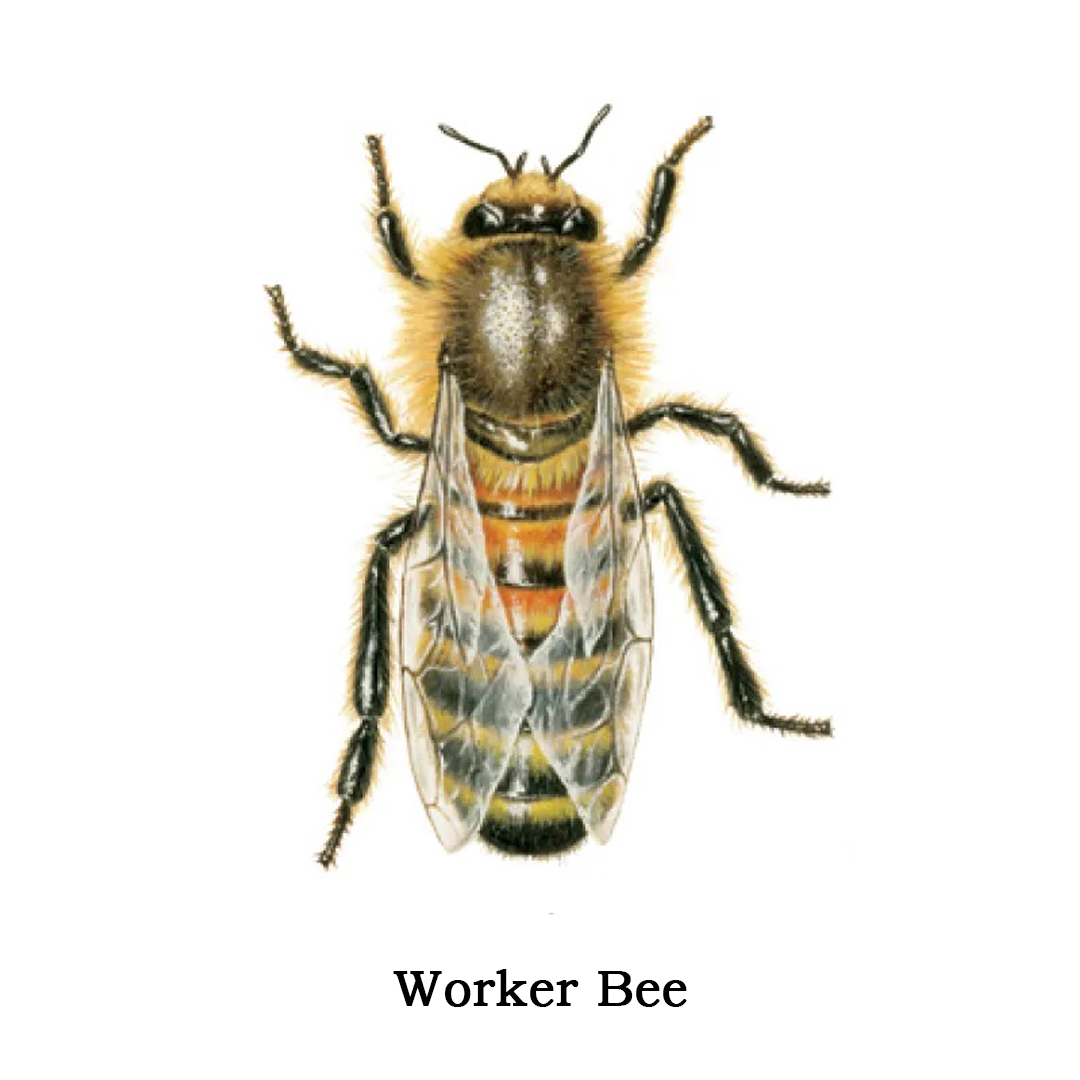
Queen Bee:
Each honeybee colony usually has only one fertile female, the queen and she lays all the eggs in the hive.
In the spring, when the colony is growing at its fastest pace, a productive queen can lay up to 2 000 eggs per day.
She spends most of her life in the brood chamber of the hive and depends on the worker bees to feed her and dispose of her waste.
When worker bees decide that a new queen is needed (because, for example, her egg production is dwindling), they feed a new larva on royal jelly alone.
As a result, it develops into a sexually mature female bee. She is fed only royal jelly for the rest of her life, which can be up to four years.
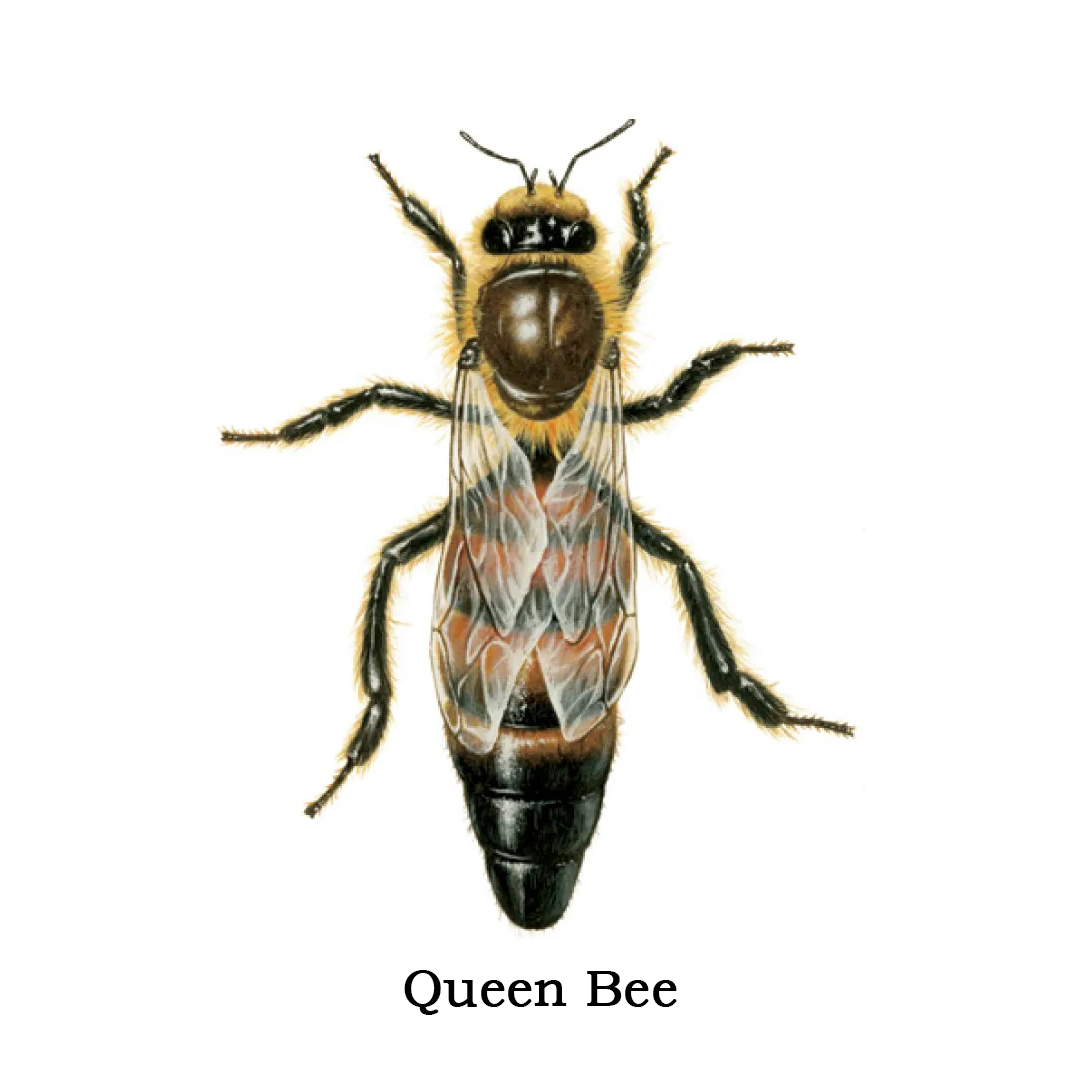
Drone Bees
Drones are male bees and their sole purpose is to mate with the queen: they don't work, don't make honey and can't sting.
Since a queen only needs to mate once, most of the drones won't even get the chance to fulfil their role. But worker bees keep them around, just in case a new queen needs mating.
Drones usually live for about eight weeks and, in that time, have all their needs met by worker bees.
In the fall, the worker bees kick the drones out of the hive because keeping them through the winter demands too much work and food
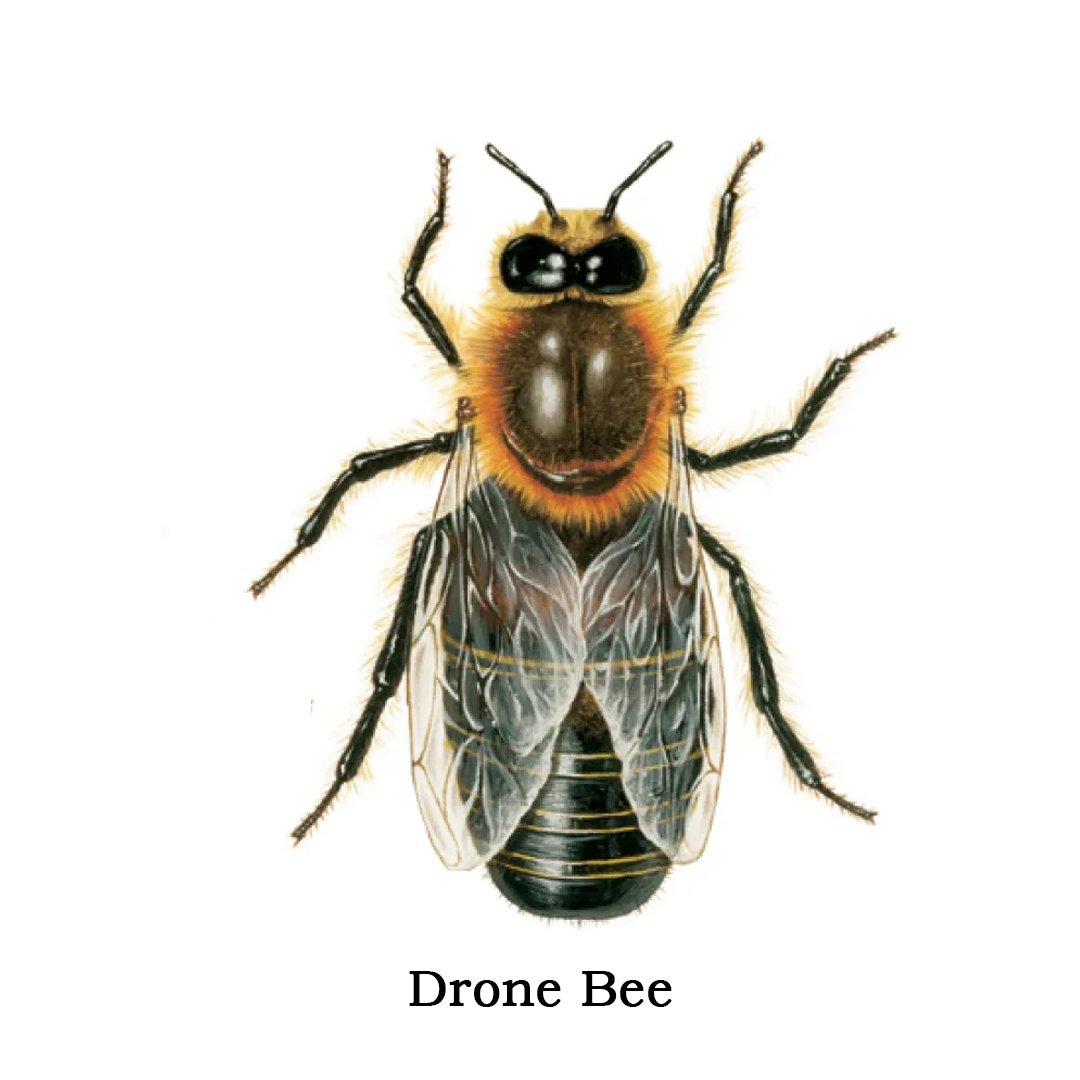
Pollination:


What is pollination?
The most important thing that bees do is pollinate. Pollination is needed for plants to reproduce, and so many plants depend on bees or other insects as pollinators.
When a bee collects nectar and pollen from the flower of a plant, some pollen from the stamens—the male reproductive organ of the flower—sticks to the hairs of her body. When she visits the next flower, some of this pollen is rubbed off onto the stigma, or tip of the pistil—the female reproductive organ of the flower. When this happens, fertilization is possible, and a fruit, carrying seeds, can develop.
Of all the honey bee species, only Apis mellifera has been used extensively for commercial pollination of fruit and vegetable crops followed by Serena Indica . About 80 % crops are being pollinated by bees where both the self as well as cross pollinated crops are benefited. Due to pollination it is observed that nearly 20 to 200 % crop yield is been increased. Due to this providing honeybee colonies on rent basis for pollination service has become the worldwide business and beekeepers are getting huge amount from this business.
Bee products
Honey-Honey is product made from flower nectar, process it and store into honey combs. A. mellifera and A. cerana are the only species which are commercially reared and honey harvested. Honey is also collected from rock bee.
Beeswax
Worker bees at certain age secrete beeswax from glands on their abdomens. They use the wax to form the walls and caps of the cell. Beeswax is gathered by humans for various purposes such as candle making, waterproofing, soap and cosmetics manufacturing, pharmaceuticals, art, furniture polish and more.
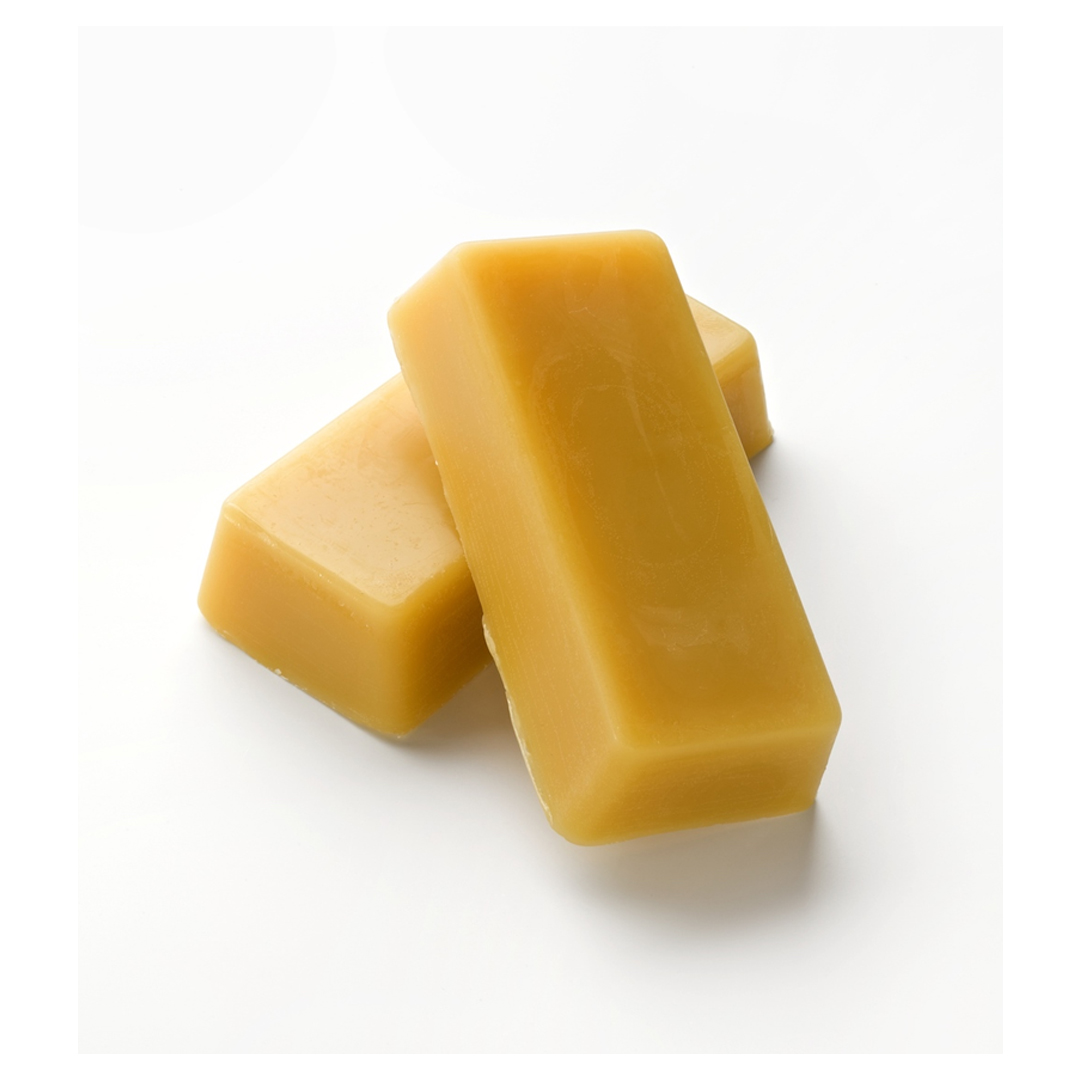
Bee pollen
Bees collect pollen in their pollen baskets and carry to the colony. Worker bees combine pollen, honey and glandular secretions and allow it to ferment in the comb to make bee bread. The fermentation process releases additional nutrients from the pollen and can produce antibiotics and fatty acids which inhibit spoilage. Bee bread is eaten by nurse bees (younger workers) which produce the protein-rich royal jelly needed by the queen and developing larvae in their hypopharyngeal glands. In the hive, pollen is used as a protein source necessary during brood-rearing. In certain environments, excess pollen can be collected from the hives of Apis mellifera and Apis cerana. The product is used as a health supplement.

Propolis
Propolis is a resinous mixture collected by honey bees from tree buds, sap flows or other botanical sources, which is used to close the unwanted openings of bee boxes so that colony will protect from the nature as well as their enemies. Propolis is used in wood finishes, and gives a Stradivarius violin its unique red color.

Royal jelly
Royal jelly is a honey bee secretion used to nourish the larvae as well as Queen in the colony. It is highly valued product due to various healthy nutrients in it.

Venom
The stings of honey bees is attached to the end of abdomen which is connected to venom bag. When bee stings, end of the abdomen along with venom bag separates from the bee due to bee dies after sting. Bee venom is used in various medicine, cosmetics as well as for giving bee therapy. The honey bees venom, known as apitoxin, carries several active components, the most abundant of which is melittin and the most biologically active are enzymes, particularly phospholipase A2.
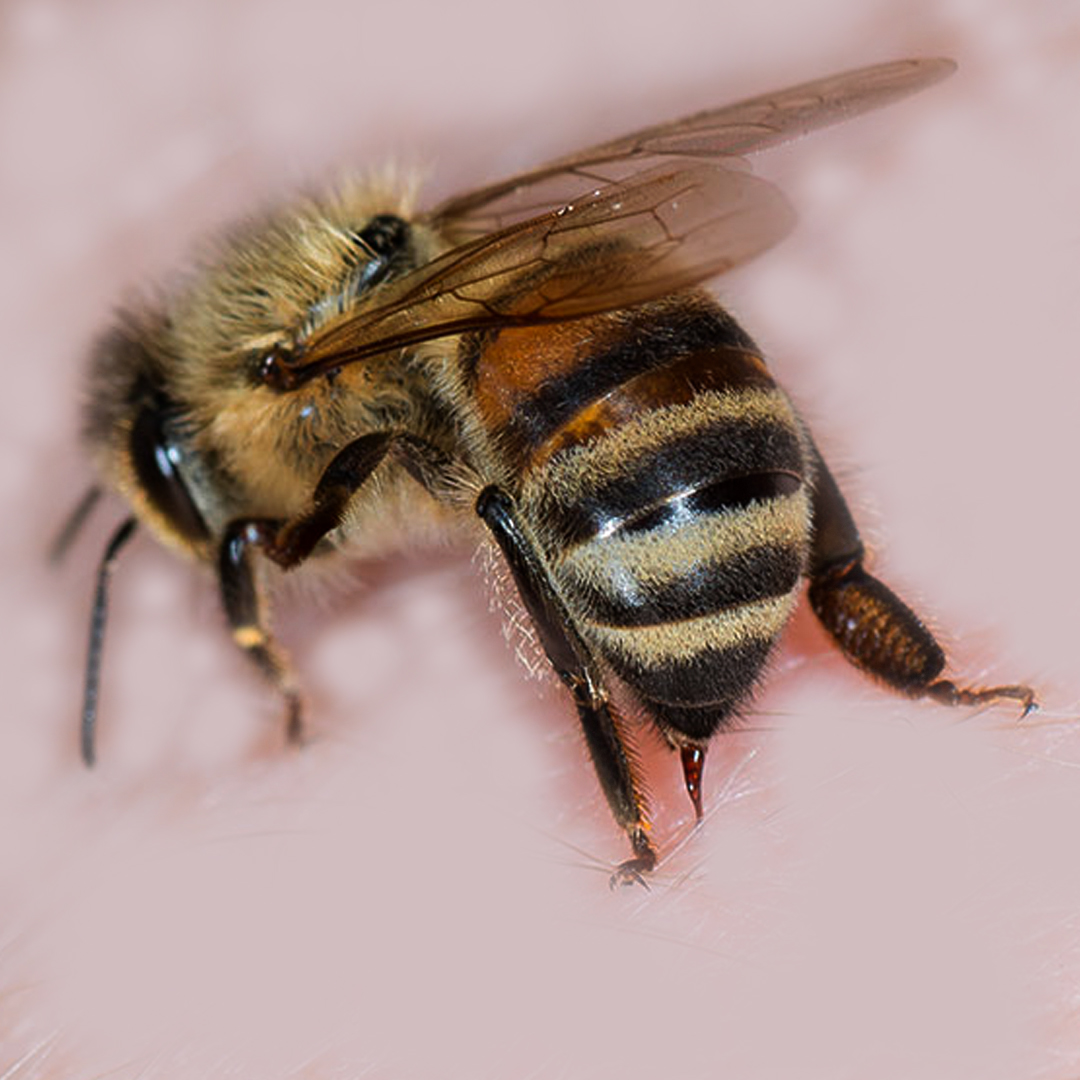
Beekeeping:

What is Beekeeping?
Beekeeping in India has been mentioned in ancient Vedas and Buddhist scriptures. Rock paintings of Mesolithic era found in Madhya Pradesh depict honey collection activities. Scientific methods of beekeeping, however, started only in the late 19th century. After Indian independence, beekeeping was promoted through various rural developmental programs. Before taking up beekeeping as a profession, one must know the basic aspects of beekeeping such as different bee species, their biology, rearing and management methods, bee enemy and diseases, bee forage, role of honey bees in crop pollination and causes for pollinator decline and mitigation.
Scientists, students, farmers, honey traders and all the stakeholders in the honey industry will benefit by the knowledge of beekeeping techniques. Beekeeping is the ancient agricultural practice of managing honey bees in enclosed structures called beehives. Beekeepers may obtain crop pollination services from these bees and harvest their honey, beeswax, pollen, and other products. Beekeeping can be a hobby or commercial in nature.
Beekeeping also known as apiculture is an interesting hobby and an ideal agro-based subsidiary enterprise, providing supplementary and sometimes major income to the people in the rural areas. Honey is nature’s miraculous food. The nutritional composition of honey, is closer to fruit than it is to table sugar or any other sweetener. Honey bees are not only important for the honey and other products they provide but they are also vital as pollinators of agricultural and Honeybees is social insects and live together in hives. The honeybee is remarkable for the dancing movements it performs in the hive to communicate information to its fellow bees about the location, distance, size, and quality of a particular food source in the surrounding area. Honey bees are considered to be very healthy and they are made up of important enzymes, minerals, proteins and vitamins besides pollinating the crops. Honey contain an antioxidant that is associated with improved brain functioning and hence in certain ethnicities and cultural regions around the world, the honey is consumed as a daily staple. The fructose and glucose that is found in honey are digested by human beings and hence the pure honey collected by honey bees are used by human beings for a healthy lifestyle. The honey that honey bees collect also has medicinal value and is used in treating certain throat infections digestive disorders or skin problems. During the peak season on a collection trip, one honey bee collects honey from almost 80 to 100 flowers. A colony of honey bee consists of 20,000 to 50,000 worker bees, 200 to300 male/drone and one queen. One bee flies more than 90 thousand miles to collect one pound of honey. In a lifetime, a honey bee travels as much as
10 times around the globe to build hives and collect honey for their colony. Honey Bees communicate with each other by body actions and dancing.








